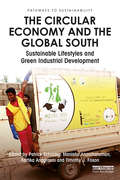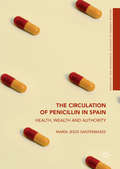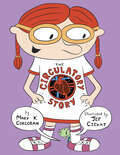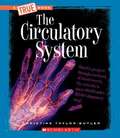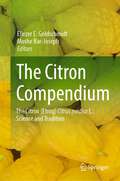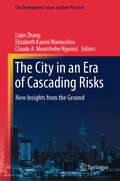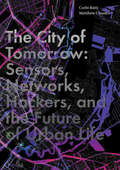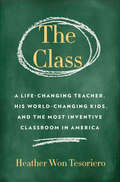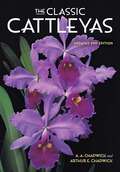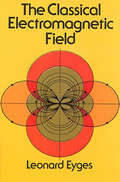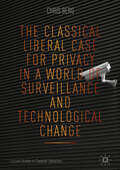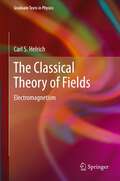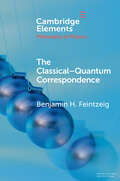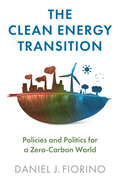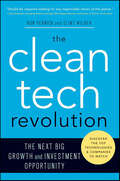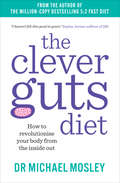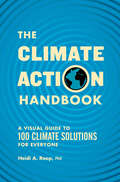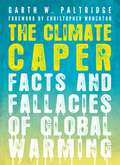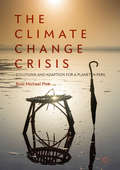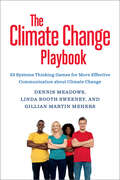- Table View
- List View
The Circular Economy and the Global South: Sustainable Lifestyles and Green Industrial Development (Pathways to Sustainability)
by Patrick Schröder Manisha Anantharaman Kartika Anggraeni Timothy FoxonThe circular economy is a policy approach and business strategy that aims to improve resource productivity, promote sustainable consumption and production and reduce environmental impacts. This book examines the relevance of the circular economy in the context of developing countries, something which to date is little understood. This volume highlights examples of circular economy practices in developing country contexts in relation to small and medium enterprises (SMEs), informal sector recycling and national policy approaches. It examines a broad range of case studies, including Argentina, Brazil, China, Colombia, India, Indonesia, Kenya, South Africa, and Thailand, and illustrates how the circular economy can be used as a new lens and possible solution to cross-cutting development issues of pollution and waste, employment, health, urbanisation and green industrialisation. In addition to more technical and policy oriented contributions, the book also critically discusses existing narratives and pathways of the circular economy in the global North and South, and how these differ or possibly even conflict with each other. Finally, the book critically examines under what conditions the circular economy will be able to reduce global inequalities and promote human development in the context of the Sustainable Development Goals. Presenting a unique social sciences perspective on the circular economy discourse, this book is relevant to students and scholars studying sustainability in economics, business studies, environmental politics and development studies.
The Circulation of Penicillin in Spain: Health, Wealth and Authority (Medicine and Biomedical Sciences in Modern History)
by María Jesús SantesmasesThis book reconstructs the early circulation of penicillin in Spain, a country exhausted by civil war (1936–1939), and oppressed by Franco’s dictatorship. Embedded in the post-war recovery, penicillin’s voyages through time and across geographies – professional, political and social – were both material and symbolic. This powerful antimicrobial captivated the imagination of the general public, medical practice, science and industry, creating high expectations among patients, who at times experienced little or no effect. Penicillin’s lack of efficacy against some microbes fueled the search for new wonder drugs and sustained a decades-long research agenda built on the post-war concept of development through scientific and technological achievements. This historical reconstruction of the social life of penicillin between the 1940s and 1980s – through the dictatorship to democratic transition – explores political, public, medical, experimental and gender issues, and the rise of antibiotic resistance.
The Circulatory Story
by Jef Czekaj Mary K. CorcoranHumorous text paired with comic illustrations, brings anatomy and science of the body to life for young readers in this exploration of the circulatory system. From the author and illustrator of THE QUEST TO DIGEST comes another playful way to learn about the body and its inner workings. Readers follow a red blood cell on its journey through the heart, lungs, veins, arteries, capillaries, and more, as they see how the body combats disease, performs gas exchanges, and fights plaque. This whimsical glimpse into the human body is fun and informative, perfect for the classroom or the home, and is sure to please the most curious of readers.
The Circulatory Story
by Mary CorcoranSimple, humorous text and comic illustrations explain the basics of the circulatory system--the systemic, pulmonary, and coronary circuits. Readers follow a red blood cell on its journey through the body, and in the process learn how the body combats disease, performs gas exchanges, and fights plaque.
The Circulatory System (True Books)
by Christine Taylor-ButlerDid you know that your nerve impulses are 1,000 times SLOWER than your computer? Or that it's normal to fart - as often as 20 times a day? Get the buzz on health and the human body with this fun and fascinating series.
The Circulatory System (Your Body Systems Ser.)
by Rebecca PettifordOur bodies contain a super highway of blood vessels that carry nutrients, waste, and much more from our heads to our toes. This network is the circulatory system! Beginning with a deep breath in, this fact-filled title uses easy-to-follow text and diagrams to allow readers to dive inside the bodys circulatory system! The human body is a complex being made up of systems that keep us alive and moving! In this series, readers will dive into the bodys systems though engaging, leveled text and related diagrams that follow the parts and functions of each system. Get a microscopic view inside the body with A Closer Look, and put new knowledge into action with a hands-on activity. Check out what is happening inside the body with each title!
The Citron Compendium: The Citron (Etrog) Citrus medica L.: Science and Tradition
by Moshe Bar-Joseph Eliezer E. GoldschmidtThis comprehensive book covers the theoretical and practical aspects of citron trees and fruit. The citron (Citrus medica L.), one of the three primary species ancestral to most citrus types, is used for traditional medicine and is highly revered in the Jewish religion during the Tabernacles feast, referred to by the name 'Etrog'. This book’s three sections address biology (botany, genomics, Chinese and Mediterranean citrons, diseases, pests, and horticulture), tradition (Talmudic discourse, mysticism, medicine, literature, art, food, and beverages) and history (archaeology, trade, grafting controversies); these sections are supplemented by a glossary and pictorial album. The 22 chapters, some new and some translated and considerably expanded from the 2018 Hebrew edition, were written by world-renowned specialists from Israel, Italy, France, the U.S.A., China and Australia. The book is written in an accessible scientific style aimed at a wide range of readers.
The Citrus Genome (Compendium of Plant Genomes)
by Alessandra Gentile Stefano La Malfa Ziniu DengThis book reviews how the release of the citrus genome facilitates the investigation of ancestral species, the study of their complex biological features, and the genetic basis of agronomic traits of paramount importance for their sustainable cultivation. The first chapters discuss citrus origin and distribution, and the economic importance and varietal composition of the cultivated species, providing an overview of citrus and related genera genetic resources. The book then describes the role of traditional breeding techniques (for scion and rootstocks) as well as the potential of genomic breeding and innovative protocols for biotechnological approaches. The second part provides essential information on the genus Citrus, the attributes of pure citrus species, genetic admixtures, hybrids and citrus relatives, and on the horticultural classification of cultivated species, varieties and rootstocks. The third part then focuses on the different molecular mechanisms, covering various aspects of citrus biology, including the role of beneficial compounds of citrus fruits. In addition, it examines the molecular responses of citrus to abiotic stresses and to field and post-harvest diseases. Providing insights gained in recent years, it is a valuable guide for those who are interested in gene discovery, comparative genomics, molecular breeding and new breeding techniques. It is particularly useful for scientists, breeders and students at universities and public sector institutes involved in research for the citrus industry.
The City in an Era of Cascading Risks: New Insights from the Ground (City Development: Issues and Best Practices)
by Liqin Zhang Elizabeth Kanini Wamuchiru Claude A. Meutchehe NgomsiThis book provides unique perspectives into newly changed political and socioeconomic urban landscapes due to COVID-19 in diverse cities and aims to provide ways to improve the resilience of cities using a global perspective, especially in a post-pandemic era. This book is divided into three sections with seventeen chapters overall. It explores the impacts of the COVID-19 on city planning, building, and maintenance; it considers city resilience and what urban risks cities are facing; and it examines urban development from diverse socioeconomic and political perspectives. The book contains multidisciplinary work by authors from China, African nations (Angola, Burundi, Cameroon, Kenya, Morocco, Nigeria), Canada, Italy, Poland, and France. This manuscript provides a global perspective as cities from Africa, China, as well as some developed countries, such as France and South Korea, were used to collect data and information concerning urban development and risks, past, present, and future responses to COVID-19 as well as any other pandemics and cities' resilience. This book is a valuable asset to urban researchers, urban city planners, urban policymakers, public officials, undergraduates, and postgraduates interested in a comprehensive comparison between diverse socioeconomic and political cities with a unique global and post-pandemic perspective in order to improve urban city resilience.
The City in the Stars (Tom Swift III, Book #1)
by Victor AppletonFrom the back of the book: The mysterious explosion of Tom's new spaceship forces him and his buddy Ben to investigate Dr. Hans Grotz, a respected scientist and director of New America, a fantastic orbiting space colony. At the same time, Tom is testing his recent invention, a high-powered engine that will launch the Daniel Boone, Swift Enterprises latest spacecraft. Someone is sabotaging the test engine, endangering hundreds of lives. Who is bent on destroying Swift Enterprises? Tom and his new-found allies, Anita Thorwald and Benjamin Franklin Walking Eagle, battle sinister forces in this cosmic adventure.
The City of Tomorrow: Sensors, Networks, Hackers, and the Future of Urban Life
by Carlo Ratti Matthew ClaudelSince cities emerged ten thousand years ago, they have become one of the most impressive artifacts of humanity. But their evolution has been anything but linear--cities have gone through moments of radical change, turning points that redefine their very essence. In this book, a renowned architect and urban planner who studies the intersection of cities and technology argues that we are in such a moment. Â The authors explain some of the forces behind urban change and offer new visions of the many possibilities for tomorrow's city. Pervasive digital systems that layer our cities are transforming urban life. The authors provide a front-row seat to this change. Their work at the MIT Senseable City Laboratory allows experimentation and implementation of a variety of urban initiatives and concepts, from assistive condition-monitoring bicycles to trash with embedded tracking sensors, from mobility to energy, from participation to production. They call for a new approach to envisioning cities: futurecraft, a symbiotic development of urban ideas by designers and the public. With such participation, we can collectively imagine, examine, choose, and shape the most desirable future of our cities.
The Class: A Life-Changing Teacher, His World-Changing Kids, and the Most Inventive Classroom in America
by Heather Won TesorieroAn unforgettable year in the life of a visionary high school science teacher and his award-winning students, as they try to get into college, land a date for the prom . . . and possibly change the world Andy Bramante left his successful career as a corporate scientist to teach public high school—and now helms one of the most remarkable classrooms in America. Bramante’s unconventional class at Connecticut’s prestigious yet diverse Greenwich High School has no curriculum, tests, textbooks, or lectures, and is equal parts elite research lab, student counseling office, and teenage hangout spot. United by a passion to learn, Mr. B.’s band of whiz kids set out every year to conquer the brutally competitive science fair circuit. They have won the top prize at the Google Science Fair, made discoveries that eluded scientists three times their age, and been invited to the Nobel Prize ceremony in Stockholm. A former Emmy-winning producer for CBS News, Heather Won Tesoriero embeds in this dynamic class to bring Andy and his gifted, all-too-human kids to life—including William, a prodigy so driven that he’s trying to invent diagnostics for artery blockage and Alzheimer’s (but can’t quite figure out how to order a bagel); Ethan, who essentially outgrows high school in his junior year and founds his own company to commercialize a discovery he made in the class; Sophia, a Lyme disease patient whose ambitious work is dedicated to curing her own debilitating ailment; Romano, a football player who hangs up his helmet to pursue his secret science expertise and develop a “smart” liquid bandage; and Olivia, whose invention of a fast test for Ebola brought her science fair fame and an appearance on The Late Show with Stephen Colbert. We experience the thrill of discovery, the heartbreak of failed endeavors, and perhaps the ultimate high: a yes from Harvard. Moving, funny, and utterly engrossing, The Class is a superb account of hard work and high spirits, a stirring tribute to how essential science is in our schools and our lives, and a heartfelt testament to the power of a great teacher to help kids realize their unlimited potential.Advance praise for The Class“A riveting look at a year in the life of an inspiring teacher and how he is helping kids create amazing and award-winning science projects. With the turn of every page, we see the joys of discovery and the immense satisfaction this brings to Andy Bramante, who made a life choice that transforms his students’ lives every day.”—Walter Isaacson, author of the New York Times bestseller Steve Jobs
The Classic Cattleyas
by A. A. Chadwick Arthur E. ChadwickIn 1818, William Cattley succeeded in flowering one of the first species of the genus that would bear his name. These first cattleyas are the classic cattleyas, whose form defined the essence of tropical orchids for generations to come. Indeed, the color of their flowers became known as "orchid." In this helpful and informative book, each classic Cattleya species is described in fascinating detail, and its role in breeding programs is elucidated. All that is required to appreciate and grow the large-flowered cattleyas successfully is included. Cultivation, humidity and watering, fertilizing, propagation, and diagnosing and treating problems are detailed, making this volume valuable for both veteran orchid enthusiasts and those who simply love these beautiful flowers.
The Classical Electromagnetic Field (Dover Books on Physics)
by Leonard EygesThe Classical Electromagnetic Field emphasizes physics first, then mathematics. This and the fact that lucid exposition of theory receives priority over subsequent manipulation marks the book unusual, not to say unique, among field physics texts for advanced undergraduates and graduate students. Long experience of and dissatisfaction with existing texts used in teaching electromagnetic theory at MIT prompted the author to clarify his own approach, resulting in this book. Dr. Eyges is now a Senior Research Physicist at the Rome Air Development Center, Hanscom Air Force Base.Electromagnetic theory is basic to classical and relativistic physics at every level. This text covers material for a year's course in advanced theoretical electromagnetism, at all times keeping mathematics ancillary to the physics. Prior knowledge of differential equations and vector analysis will prepare the reader for inquiry into:* meaning and definition of vectors D and H inside matter* interpretations of the conservation laws for energy, momentum and angular momentum* localization and flow of electromagnetic energy* concepts of invariance, form invariance and covariance in special relativitySummation problems form a kind of pattern in treating all the topics, which include general boundary value, dielectrics, time-varying fields, time-harmonic currents and propagation in imperfect conductors. Problems (no solutions) and references (annotated) are found at the end of each chapter; a general bibliography is also appended. Students have discovered this book in its earlier hardcover edition to be a stimulating exploration of theory, self-contained and suitable for unsupervised study; physicists and professors will find more than one fresh insight into their field.
The Classical Liberal Case for Privacy in a World of Surveillance and Technological Change (Palgrave Studies in Classical Liberalism)
by Chris BergHow should a free society protect privacy? Dramatic changes in national security law and surveillance, as well as technological changes from social media to smart cities mean that our ideas about privacy and its protection are being challenged like never before. In this interdisciplinary book, Chris Berg explores what classical liberal approaches to privacy can bring to current debates about surveillance, encryption and new financial technologies. Ultimately, he argues that the principles of classical liberalism – the rule of law, individual rights, property and entrepreneurial evolution – can help extend as well as critique contemporary philosophical theories of privacy.
The Classical Theory of Fields
by Carl S. HelrichThe study of classical electromagnetic fields is an adventure. The theory is complete mathematically and we are able to present it as an example of classical Newtonian experimental and mathematical philosophy. There is a set of foundational experiments, on which most of the theory is constructed. And then there is the bold theoretical proposal of a field-field interaction from James Clerk Maxwell. This textbook presents the theory of classical fields as a mathematical structure based solidly on laboratory experiments. Here the student is introduced to the beauty of classical field theory as a gem of theoretical physics. To keep the discussion fluid, the history is placed in a beginning chapter and some of the mathematical proofs in the appendices. Chapters on Green's Functions and Laplace's Equation and a discussion of Faraday's Experiment further deepen the understanding. The chapter on Einstein's relativity is an integral necessity to the text. Finally, chapters on particle motion and waves in a dispersive medium complete the picture. High quality diagrams and detailed end-of-chapter questions enhance the learning experience.
The Classical–Quantum Correspondence (Elements in the Philosophy of Physics)
by Benjamin H. FeintzeigThis Element provides an entry point for philosophical engagement with quantization and the classical limit. It introduces the mathematical tools of C*-algebras as they are used to compare classical and quantum physics. It then employs those tools to investigate philosophical issues surrounding theory change in physics. It discusses examples in which quantization bears on the topics of reduction, structural continuity, analogical reasoning, and theory construction. In doing so, it demonstrates that the precise mathematical tools of algebraic quantum theory can aid philosophers of science and philosophers of physics.
The Classification Of Sex: Alfred Kinsey And The Organization Of Knowledge
by Donna DruckerAlfred C. Kinsey’s revolutionary studies of human sexual behavior are world-renowned. His meticulous methods of data collection, from comprehensive entomological assemblies to personal sex history interviews, raised the bar for empirical evidence to an entirely new level. In The Classification of Sex, Donna J. Drucker presents an original analysis of Kinsey’s scientific career in order to uncover the roots of his research methods. She describes how his enduring interest as an entomologist and biologist in the compilation and organization of mass data sets structured each of his classification projects. As Drucker shows, Kinsey’s lifelong mission was to find scientific truth in numbers and through observation—and to record without prejudice in the spirit of a true taxonomist. <p><p> Kinsey’s doctoral work included extensive research of the gall wasp, where he gathered and recorded variations in over six million specimens. His classification and reclassification of Cynips led to the speciation of the genus that remains today. During his graduate training, Kinsey developed a strong interest in evolution and the links between entomological and human behavior studies. In 1920, he joined Indiana University as a professor in zoology, and soon published an introductory text on biology, followed by a coauthored field guide to edible wild plants. <p> In 1938, Kinsey began teaching a noncredit course on marriage, where he openly discussed sexual behavior and espoused equal opportunity for orgasmic satisfaction in marital relationships. Soon after, he began gathering case histories of sexual behavior. As a pioneer in the nascent field of sexology, Kinsey saw that the key to its cogency was grounded in observation combined with the collection and classification of mass data. To support the institutionalization of his work, he cofounded the Institute for Sex Research at Indiana University in 1947. He and his staff eventually conducted over eighteen thousand personal interviews about sexual behavior, and in 1948 he published Sexual Behavior in the Human Male, to be followed in 1953 by Sexual Behavior in the Human Female. <p> As Drucker’s study shows, Kinsey’s scientific rigor and his early use of data recording methods and observational studies were unparalleled in his field. Those practices shaped his entire career and produced a wellspring of new information, whether he was studying gall wasp wings, writing biology textbooks, tracing patterns of evolution, or developing a universal theory of human sexuality.
The Clean Energy Transition: Policies and Politics for a Zero-Carbon World
by Daniel J. FiorinoIs the goal of a transition to clean energy at all realistic? If so, how could it be accomplished? Climate change poses a formidable challenge for twenty-first-century governments. Unless they can move to a clean energy system built on efficiency, renewables, electrification, and possibly complementary technologies like nuclear energy and carbon capture and storage, it will be all but impossible to avoid the worst impacts of climate change. In this book, Daniel Fiorino provides a comprehensive introduction to the politics and policies of a clean energy transition and how it may unfold nationally and globally. Across its nine chapters, he explores the current energy landscape and the different pathways and pitfalls on the road to decarbonization. All scenarios for decarbonizing, he argues, rely on aggressive efficiency, the rapid scale-up of renewables, and the electrification of most of what is left. Yet this transition has to be accelerated and done effectively. There is little time left for second chances if we are to decarbonize later this century. The Clean Energy Transition will be an indispensable resource for students of energy politics, environmental studies, and public policy, as well as anyone interested in the energy issues of the day.
The Clean Tech Revolution: The Next Big Growth and Investment Opportunity
by Clint Wilder Ron PernickWhen industry giants such as GE, Toyota, and Sharp and investment firms such as Goldman Sachs are making multibillion-dollar investments in clean technology, the message is clear. Developing clean technologies is no longer a social issue championed by environmentalists; it's a moneymaking enterprise moving solidly into the business mainstream. In fact, as the economy faces unprecedented challenges from high energy prices, resource shortages, and global environmental and security threats, clean tech—technologies designed to provide superior performance at a lower cost while creating significantly less waste than conventional offerings—promises to be the next engine of economic growth.In The Clean Tech Revolution, authors Ron Pernick and Clint Wilder identify the major forces that have pushed clean tech from back-to-the-earth utopian dream to its current revolution among the inner circles of corporate boardrooms, on Wall Street trading floors, and in government offices around the globe. By highlighting eight major clean-tech sectors—solar energy, wind power, biofuels and biomaterials, green buildings, personal transportation, the smart grid, mobile applications, and water filtration—they uncover how investors, entrepreneurs, and individuals can profit from this next wave of technological innovation. Pernick and Wilder shine the spotlight on the winners among technologies, companies, and regions that are likely to reap the greatest benefits from clean tech—and they show you why the time to act is now.Groundbreaking and authoritative, The Clean Tech Revolution is the must-read book to understand and profit from the clean technologies that are reshaping our fast-changing world.
The Clever Guts Diet: How to revolutionise your body from the inside out
by Dr Michael Mosley**AS SEEN ON CHANNEL 4**Your gut is astonishingly clever. It contains millions of neurons - as many as you would find in the brain of a cat - and is home to the microbiome, trillions of microbes that influence your mood, your immune system, and even your appetite. In this groundbreaking book, Dr. Mosley takes us on a revelatory journey through the gut, showing how junk food and overuse of antibiotics have wiped out many good gut bacteria, leading to a modern plague of allergies, food intolerances, and obesity.Drawing from the latest cutting-edge research, Dr. Mosley provides scientifically proven ways to control your cravings, boost your mood, and lose weight by encouraging a more diverse microbiome and increasing the good bacteria that keep you healthy.Packed with delicious, healing recipes, meal plans, checklists, and tips.The Clever Guts Diet includes all the tools you need to transform your gut and your health, for life.
The Climate Action Handbook: A Visual Guide to 100 Climate Solutions for Everyone
by Heidi RoopThis must-have book shows us WHY we need to take action now to combat climate change and then, critically, HOW, through easy-to-understand language and fascinating infographics that offer each of us varied and doable solutions to the overwhelming challenges facing our planet. As more focus is put on climate science, there is a need for each of us to learn how we can change our habits in our home, communities, and government to save our planet. Enter The Climate Action Handbook. A visually stunning guide, it does what no other climate change book manages to do: it's approachable, digestible, and offers the average person ideas, options, and a roadmap for action. It also offers hope—often overlooked in climate change conversations. Climate actions can create near-instantaneous improvements in air quality and can offer ways to address societal inequities, green our communities, save money, and build local economies. Stunning and creative infographics help anyone easily grasp the many challenges facing our planet, as well as how every action—be it on the individual, local, or government level—matters. From food and fashion choices, rethinking travel, greening up our homes and gardens, to civic engagement and championing community climate planning, Dr. Heidi Roop shares 100 wide-ranging ways that readers from all walks of life can help move the needle in the right direction. Actions include: • Cutting down on food waste • Reducing your driving speed • Voting in every election • Using the cold-water cycle on your washing machine • Supporting healthy soils in your gardens and community green spaces • Engaging in local climate action planning • Preparing an emergency kit for your home • Deleting unused emails and online accounts • Swapping out milk for nondairy alternatives like oat milk • Opting for slower shipping whenever possible • Regularly maintaining and clean your heating and cooling systems • Engaging in climate conversations at work and at home And many more!Return to this invaluable resource again and again to discover a roadmap for action and much-needed hope. What will your climate journey look like?
The Climate Caper: Facts and Fallacies of Global Warming
by Garth W. PaltridgeSo you think the theory of disastrous climate change has been proven? You believe scientists are united in their efforts to affect a reduction in carbon emissions? You trust that scientists are far too professional to overstate their case? Maybe we should all think again. In The Climate Caper, written with a light touch and a readable manner, Garth Paltridge shows that the case for action against climate change is not nearly so clear cut after all. He leads us through the inherent problems of the climate modeling process, as well as the uncertainties associated with economic forecasts of climatic doom. Paltridge uncovers the conscious and subconscious forces that hide skepticism within the scientific community from the public eye and submit governments to a scientific and technological elite-an elite that achieves its ends by manipulating the public through fear of climate change, creating the world's greatest example of a religion for the politically correct.
The Climate Change Crisis: Solutions And Adaption For A Planet In Peril
by Ross Michael PinkThis book explores how the world community will respond to the unfolding humanitarian crisis caused by climate change. It recognises climate change as the greatest threat to human development in the 21st century, bringing with it: flooding, drought, extreme temperatures, health crises, threats to human security and severe harm to economic development.The Climate Change Crisis addresses climate change and its impact as a major threat for countries around the world. Through a collection of interviews with leading environmentalists and exploration into new innovations that can offer hope and protection for billions of people, this book presents an interdisciplinary approach towards understanding the paramount health and development challenges of climate change.This timely and informative book cuts across several disciplines, including human rights, public policy, international relations, national refugee policy, and migration studies.
The Climate Change Playbook: 22 Systems Thinking Games for More Effective Communication about Climate Change
by Dennis Meadows Linda Booth Sweeney Gillian Martin MehersAdvocates and teachers often find it difficult to communicate the complexities of climate change, because the people they are trying to reach hold so many mistaken assumptions. They assume, for example, that when climate change becomes an obvious threat to our everyday lives, there will still be time enough to make changes that will avoid disaster. Yet at that point it will be too late. Or they assume we can use our current paradigms and policy tools to find solutions. Yet the approaches that caused damage in the first place will cause even more damage in the future.Even the increasingly dire warnings from scientists haven&’t shaken such assumptions. Is there another way to reach people?The simple, interactive exercises in The Climate Change Playbook can help citizens better understand climate change, diagnose its causes, anticipate its future consequences, and effect constructive change. Adapted from The Systems Thinking Playbook, the twenty-two games are now specifically relevant to climate-change communications and crafted for use by experts, advocates, and educators. Illustrated guidelines walk leaders through setting each game up, facilitating it, and debriefing participants. Users will find games that are suitable for a variety of audiences—whether large and seated, as in a conference room, or smaller and mobile, as in a workshop, seminar, or meeting.Designed by leading thinkers in systems, communications, and sustainability, the games focus on learning by doing.
